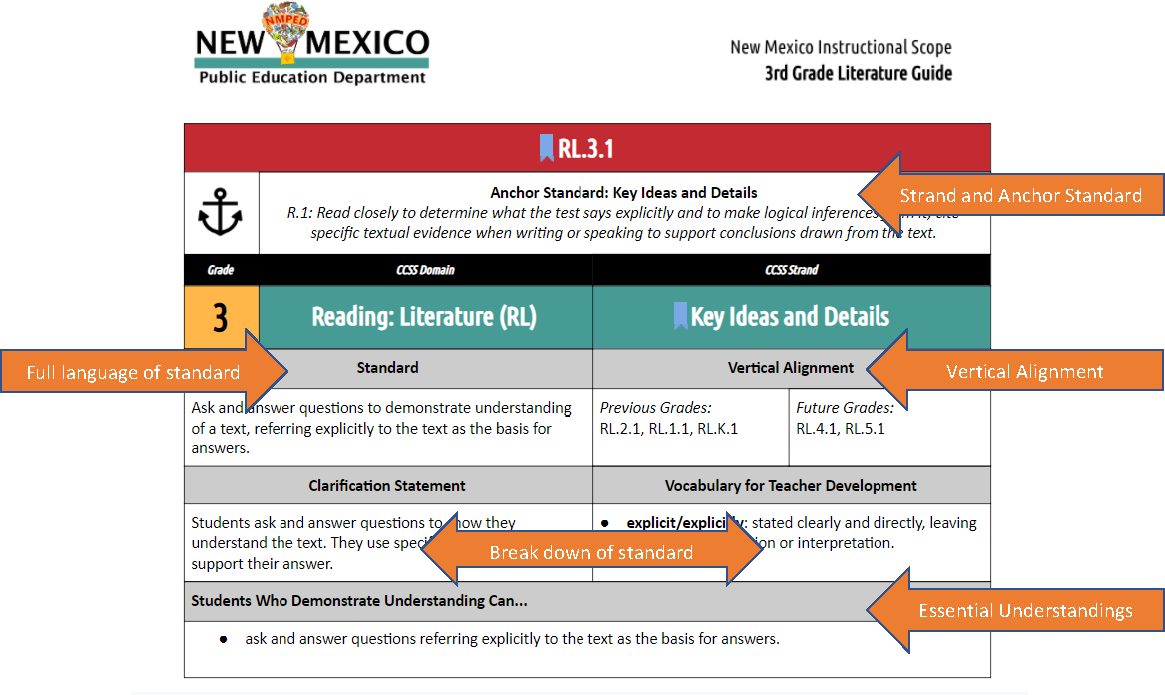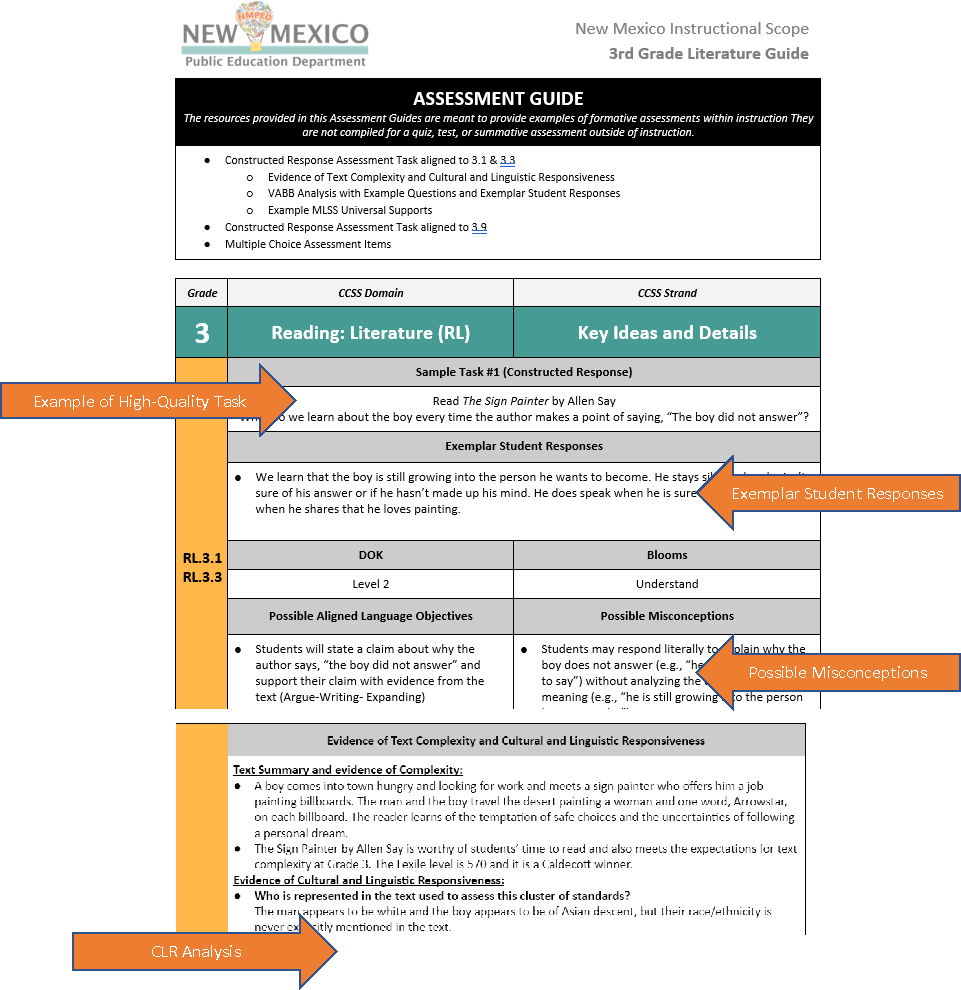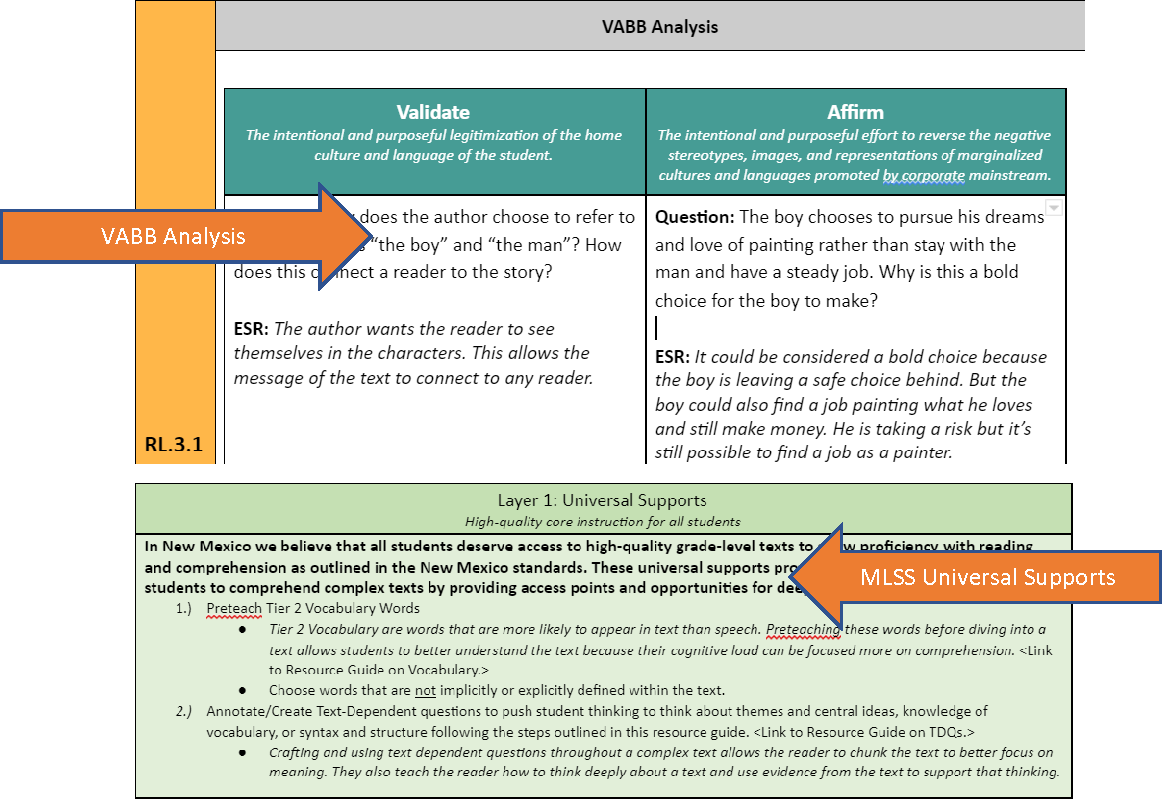K-12 standards for language arts and mathematics define what students should understand and be able to do by the end of each grade. Students should demonstrate their proficiency of these standards both orally and through writing. For students to be college- and career-ready, they must be able to read from a wide range of high-quality, increasingly challenging literary and informational texts. One of the key requirements of the standards for reading is that all students must be able to comprehend texts of steadily increasing complexity as they progress through school.
How to use the Instructional Scope for Language Arts:
- Support your lesson planning
- Guide teams to discuss, plan, model, and reflect on your practice
- Scaffold your deliberate planning and your focused conversations with your colleagues during professional learning community discussions, supporting your use of high-quality instruction that meets the needs of all learners
- Consider how to address learning needs and where targeted scaffolds may be needed to assist students in accessing grade level core instruction
- Use side by side with high-quality instructional materials
- Provides teaching support that contributes to equitable classroom structures and assists lesson planning
- Assists in designing classroom learning environments that minimize barriers and optimize learning for all students
- Monitor students’ progress on grade-appropriate assignments
What is included in the NM Instructional Scope for Language Arts:
- instructional tenets
- planning guidance
- resources
- culturally and linguistically responsive instruction
- assessment
- cross-curricular connections
- acceleration guidance
Unpacking the Standards
What is in the unpacking of the standards?
ELA standards have been broken down to give clarity around what the standard means as well as clarity around student performance. There are also instructionally embedded formative assessments offered that align with clusters of literature and informational text standards. These formative assessments naturally allow for speaking, listening, and/or writing standards to be incorporated naturally as student performance is assessed. Due to the systematic and specific nature of foundational skills, instructionally embedded formative assessments should be pulled from the high-quality instructional materials used for daily lessons.
You are encouraged to read the NM Instructional Scope in its entirety. You will then find each section of the scope broken down into separate PDFs.
Should you need assistance, please contact the Literacy and Humanities Bureau staff.
Kindergarten
- Standards
- Companion Guides
- Planning Literacy Instruction with MLSS Guide
- Choosing a Complex Text
- Text Dependent Questions with Complex Texts
- Vocabulary Instruction with Complex Texts
- Speaking, Listening, and Writing
- Differentiating Support for All Learners
- Cross-Curricular Connections with Literacy
- Cultural and Linguistic Responsiveness in Literacy
1st Grade
- Standards
- Companion Guides
- Planning Literacy Instruction with MLSS Guide
- Choosing a Complex Text
- Text Dependent Questions with Complex Texts
- Vocabulary Instruction with Complex Texts
- Speaking, Listening, and Writing
- Differentiating Support for All Learners
- Cross-Curricular Connections with Literacy
- Cultural and Linguistic Responsiveness in Literacy
2nd Grade
- Standards
- Companion Guides
- Planning Literacy Instruction with MLSS Guide
- Choosing a Complex Text
- Text Dependent Questions with Complex Texts
- Vocabulary Instruction with Complex Texts
- Speaking, Listening, and Writing
- Differentiating Support for All Learners
- Cross-Curricular Connections with Literacy
- Cultural and Linguistic Responsiveness in Literacy
3rd Grade
- Standards
- Companion Guides
- Planning Literacy Instruction with MLSS Guide
- Choosing a Complex Text
- Text Dependent Questions with Complex Texts
- Vocabulary Instruction with Complex Texts
- Speaking, Listening, and Writing
- Differentiating Support for All Learners
- Cross-Curricular Connections with Literacy
- Cultural and Linguistic Responsiveness in Literacy
4th Grade
- Standards
- Companion Guides
- Planning Literacy Instruction with MLSS Guide
- Choosing a Complex Text
- Text Dependent Questions with Complex Texts
- Vocabulary Instruction with Complex Texts
- Speaking, Listening, and Writing
- Differentiating Support for All Learners
- Cross-Curricular Connections with Literacy
- Cultural and Linguistic Responsiveness in Literacy
5th Grade
- Standards
- Companion Guides
- Planning Literacy Instruction with MLSS Guide
- Choosing a Complex Text
- Text Dependent Questions with Complex Texts
- Vocabulary Instruction with Complex Texts
- Speaking, Listening, and Writing
- Differentiating Support for All Learners
- Cross-Curricular Connections with Literacy
- Cultural and Linguistic Responsiveness in Literacy
6th Grade
- Standards
- Companion Guides
- Planning Literacy Instruction with MLSS Guide
- Choosing a Complex Text
- Text Dependent Questions with Complex Texts
- Vocabulary Instruction with Complex Texts
- Speaking, Listening, and Writing
- Differentiating Support for All Learners
- Cross-Curricular Connections with Literacy
- Cultural and Linguistic Responsiveness in Literacy
7th Grade
- Standards
- Companion Guides
- Planning Literacy Instruction with MLSS Guide
- Choosing a Complex Text
- Text Dependent Questions with Complex Texts
- Vocabulary Instruction with Complex Texts
- Speaking, Listening, and Writing
- Differentiating Support for All Learners
- Cross-Curricular Connections with Literacy
- Cultural and Linguistic Responsiveness in Literacy
8th Grade
- Standards
- Companion Guides
- Planning Literacy Instruction with MLSS Guide
- Choosing a Complex Text
- Text Dependent Questions with Complex Texts
- Vocabulary Instruction with Complex Texts
- Speaking, Listening, and Writing
- Differentiating Support for All Learners
- Cross-Curricular Connections with Literacy
- Cultural and Linguistic Responsiveness in Literacy
9th Grade
- Standards
- Companion Guides
- Planning Literacy Instruction with MLSS Guide
- Choosing a Complex Text
- Text Dependent Questions with Complex Texts
- Vocabulary Instruction with Complex Texts
- Speaking, Listening, and Writing
- Differentiating Support for All Learners
- Cross-Curricular Connections with Literacy
- Cultural and Linguistic Responsiveness in Literacy
10th Grade
- Standards
- Companion Guides
- Planning Literacy Instruction with MLSS Guide
- Choosing a Complex Text
- Text Dependent Questions with Complex Texts
- Vocabulary Instruction with Complex Texts
- Speaking, Listening, and Writing
- Differentiating Support for All Learners
- Cross-Curricular Connections with Literacy
- Cultural and Linguistic Responsiveness in Literacy
11th Grade
- Standards
- Companion Guides
- Planning Literacy Instruction with MLSS Guide
- Choosing a Complex Text
- Text Dependent Questions with Complex Texts
- Vocabulary Instruction with Complex Texts
- Speaking, Listening, and Writing
- Differentiating Support for All Learners
- Cross-Curricular Connections with Literacy
- Cultural and Linguistic Responsiveness in Literacy
12th Grade
- Standards
- Companion Guides
- Planning Literacy Instruction with MLSS Guide
- Choosing a Complex Text
- Text Dependent Questions with Complex Texts
- Vocabulary Instruction with Complex Texts
- Speaking, Listening, and Writing
- Differentiating Support for All Learners
- Cross-Curricular Connections with Literacy
- Cultural and Linguistic Responsiveness in Literacy



